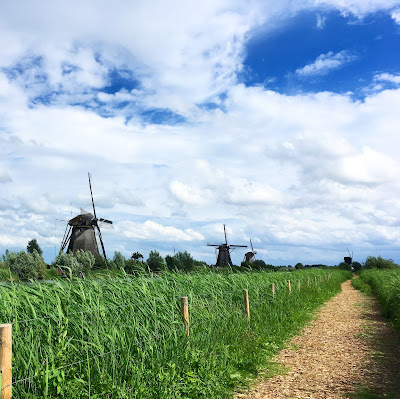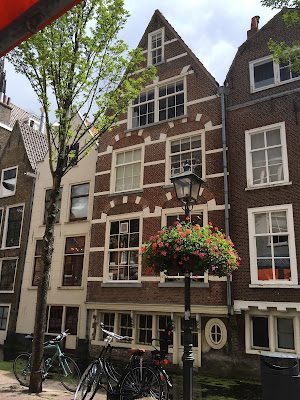Living in Dusseldorf has its ups and downs. Among the ups is the Dorf's proximity to so many cool places – like The Hague, which Kata surprised me with a trip to for my birthday.
And since I'm the one with the driver's license, she dropped a few not-so-subtle hints that I should rent a car for a destination unbeknownst to me until we punched the destination into the GPS.
The 3-hour drive from Dusseldorf to The Hague was uneventful. It wasn't boring, there's just not much on the drive there. The land flattened out and widened as we drove northwest. The countryside's features changed as we neared the sea and dipped below sea level.
This is where driving is different than flying. When you fly, you're whisked from one place to another. Other than the time spent in the plane and watching the land crawl by below you, you have no sense of the distance covered.
To drive is to get a sense of where you are and where you're going. You watch the trees thicken as you leave civilization behind. You feel the air cool as you drive into the mountains. Details between point A and B form in your mind. The journey on the road builds a mental map of a place.
The Hague was great. It's the Netherland's seat of government (not its capital, which is Amsterdam, which, I know, doesn't seem to make sense), so there are lovely old buildings and museums and squares, which turn the Dutch habit of drinking and snacking into an outdoor activity.
A few more things about The Hague. It's artsy. Piet Mondrian is hometown hero. He's the guy who painted the rectangles with the colours. M.C. Escher also lived in The Hague. We went to the museum, which used to be a royal palace. It's a lovely building with a great collection of Escher's hits. Also, there are North Sea beaches a bus ride away in The Hague.
 |
| Some Mondrian on The Hague's city hall. |
A few more things about The Hague. It's artsy. Piet Mondrian is hometown hero. He's the guy who painted the rectangles with the colours. M.C. Escher also lived in The Hague. We went to the museum, which used to be a royal palace. It's a lovely building with a great collection of Escher's hits. Also, there are North Sea beaches a bus ride away in The Hague.
Parking isn't so simple, or inexpensive, and you have to keep your head on a swivel to watch for cyclists wheezing past you on either side of your car. But that's the price you pay for driving in a bicycle country.
After two nights of beer, snacks, art, and history, we jumped into the car and began the journey back. But we had planned a few stops between The Hague and home.
Delft was our first destination. It's now a suburb of The Hague, so aside from one instance where I mistook a streetcar-only way as an entrance to a parking garage, the drive went smoothly.
Amsterdam is the prime destination in the Netherlands, but if you ever have the opportunity, I recommend a side trip to Delft. It's smaller than Amsterdam, more compact, yet also less touristic and tawdry.
There was a flea market in the main square, and as we browsed we got the sense we were surrounded by locals out for a Sunday stroll downtown. At one point the sky opened up suddenly and it began pouring rain. Everyone hid under the awnings and tents of the flea market's vendors. They knew this would be a quick rain shower. Within ten minutes, the rain stopped and everyone was back to browsing again.
 |
| Welcome to Delft. Home of the tough-ass Delft Blue pottery.. |
This being Holland, canals cut through the city's centre and there were plenty of cafes to sit out and enjoy a frosty chalice of Belgian beer. The town is known for its Delft Blue pottery, which is the white ceramics painted with blue designs. We bought some handmade specimens and got back onto the road.
There is no simple way to reach Kinderdijk. It's at a confluence of rivers, so we had the choice of taking a ferry or going out of our way to cross a bridge. We crossed the bridge, and drove down a winding narrow road, past narrow high-roofed Duch houses, shipyards, and dikes.
There is no train line here. I didn't see any buses. To get there you just drive, winding your way to Kinderdijk, which is a field with seventeen 300-year-old windmills standing idle on the reclaimed marshland where the two rivers meet.
But there's something stunning underlying that. You come to Europe and look at cathedrals and palaces, which, by their very nature, are decorative and not completely necessary.
Kinderdijk isn't decorative, but functional. These windmills are monuments to land reclamation, farming, engineering – not a ruler's vanity or a religion's glory. That's not to knock on cathedrals and palaces, they're incredible too and offer a window into history. But Kinderdijk is different in its scale, its purpose, and its dominance over the landscape and the environment itself.
Our last stop on the road to the Dorf was for dinner in Nijmegem. It was brief. We had dinner at a restaurant called Nibbles, where you order shareable plates of delicious food. It was the only place we could find that was open, but we highly recommend it.
The old town was closed, so we walked through its deserted pedestrian streets to find Nibbles. We passed far too many clothing stores with creepily realistic-looking mannequins. I was thinking about taking a photo or two to share, but then I decided that I didn't want a The Ring situation – creepy store mannequins crawling through the screen and killing me – so you'll have to use your imagination.




